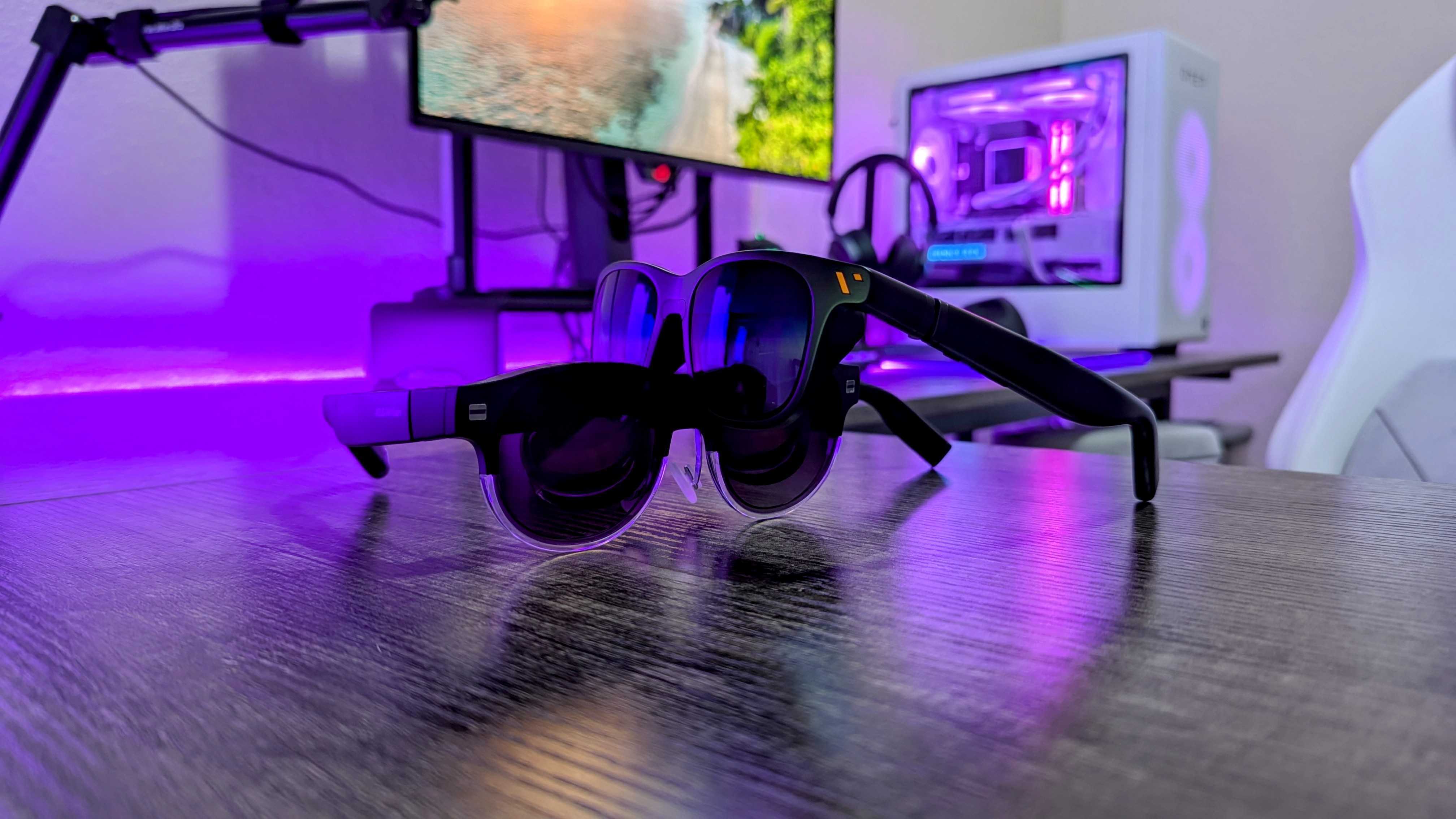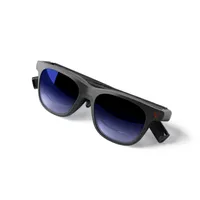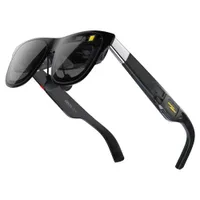Windows Central Verdict
The ASUS AirVision M1 is a solid pair of AR glasses at its core, thoughtfully designed and equipped with a respectable set of displays, but there's simply no reason to consider these over alternatives from XREAL or VITURE. I'd say the same if the AirVision M1 cost the same as those competitors, but these glasses are also $700 — $100 more than XREAL charges for its far superior flagship specs.
Pros
- +
Solid design with great transparency
- +
Optional AirVision software with 3DoF tracking
- +
Good display and audio quality
Cons
- -
Wildly overpriced
- -
Lower refresh rate, smaller FoV, and fewer features compared to competition
- -
Features locked behind AirVision software, which is exclusive to Windows
Why you can trust Windows Central
AR glasses can be a surprisingly valuable gaming accessory and productivity tool, and there's a growing number of great options.
I'd love to tell you that ASUS added another contender to the pool with its debut AirVision M1 augmented reality glasses, but I simply can't. However decent this wearable is, it simply can't compare to the best from companies like XREAL and VITURE.
The ASUS AirVision M1 would make a compelling case for itself at half the price, but ASUS is charging $700 for glasses that are no more capable or premium than its more affordable competitors, and it's baffling.
I'll still break down exactly what makes these glasses good and bad, but I'll be up front with my recommendation: the AirVision M1 doesn't earn it. Unless ASUS permanently slashes that price by 50% or more, there are much better options on the market.

I love to be on the cutting edge of personal technology, and that includes wearables like AR glasses. I've used several, including from industry leader XREAL, and know what to look for with these unique, yet surprisingly helpful accesories. Above all, that means making sure these glasses are worth the asking price.
This review was made possible thanks to a review sample provided by ASUS. ASUS had no input nor saw the contents of this review prior to publication.
AirVision M1 review: Cheat sheet
- What is it? A pair of AR glasses that can provide you with a large, private display when connected to almost any device.
- Who is it for? Those who are constantly working or gaming on the go, or see the value in a large, portable, and private display that you can take anywhere.
- How much does it cost? The ASUS AirVision M1 costs $699 at ASUS. You can also get the glasses for $699 at B&H Photo or $699.99 at Newegg.
- What did I like? The excellent transparency when used as glasses, the solid base experience, and the AirVision software.
- What did I not like? The ridiculously high cost, the lack of features, and the annoying touchpad.
AirVision M1 review: Pricing and specifications
The ASUS AirVision M1 is weirdly expensive compared to the most popular AR glasses from companies like XREAL, retailing for $699 at ASUS.
You can also get the ASUS AirVision M1 at other retailers, but it'll cost the same at $699 at B&H Photo and $669.99 at Newegg.
For comparison, the far more capable XREAL One costs just $549 at Amazon, with better displays, better audio, better tracking, and more features. Those are the glasses I'd recommend instead.
All the latest news, reviews, and guides for Windows and Xbox diehards.
Spec | ASUS AirVision M1 |
|---|---|
Display | Dual micro-OLED, FHD (1,920 x 1,080) resolution per eye, 38-degrees field-of-view (FoV), 72Hz refresh rate, 1,100nits peak brightness, up to 100-inch virtual display, 95% DCI-P3 color gamut, TÜV Rheinland Low Blue Light/Flicker Reduced certified |
Hardware features | Stereo speakers, microphone w/ noise canceling, touchpad controls, replaceable nosepads, detachable prescription lens frames, ambient light sensor, proximity sensor, 60% optical transparency |
Software features | ASUS AirVision app support, 3 degrees-of-freedom (3DoF) head tracking, adjustable Interpupillary Distance (IPD), On-Screen Display (OSD) |
Connectivity | USB Type-C, designed for Windows, compatible with any USB Type-C device w/ video, audio, & power output |
Dimensions | 171 x 170 x 53mm (6.73 x 6.69 x 2.09in) |
Weight | 87g (0.19lbs) |
Warranty | 2-year standard |
In the box, you'll find the ASUS AirVision M1 augmented reality glasses, detachable light shield, two swappable nose pad sets, your detachable prescription lens (if purchased), a USB Type-C cable, a microfiber cleaning cloth, and a hard carrying case to protect it all.
AirVision M1 review: What I like
Design-wise, the AirVision M1 is basic, but far from the worst-looking AR glasses you can buy. While heavier than its competitors, the AirVision M1 disguises its weight and girth well, and more or less looks like normal glasses.
Swappable nosepads, detachable prescription lenses, software-controlled Interpupillary Distance (IPD) adjustment, and a good amount of give in the stems make it easy to tailor these glasses to your head shape and eyes, too.
An angled Type-C cable allows for a seamless connection to your devices, and the stereo speakers are well-positioned to fire audio directly into your ears. The fundamentals were hit, and ASUS did go above and beyond in one regard.
A flaw with AR glasses is how much they obstruct your vision of the real world, thanks to their specialized lens, but the AirVision M1 is significantly clearer than the average. ASUS quotes 60% optical clarity with these glasses versus the 12% in some alternatives, and you do notice it.
The AirVision M1 is clear enough that I could clearly read small text while wearing them — and I don't mean by looking around the angled lens in the center that reflects the displays into your eyes, I mean looking directly ahead like I would wearing any other pair of glasses.

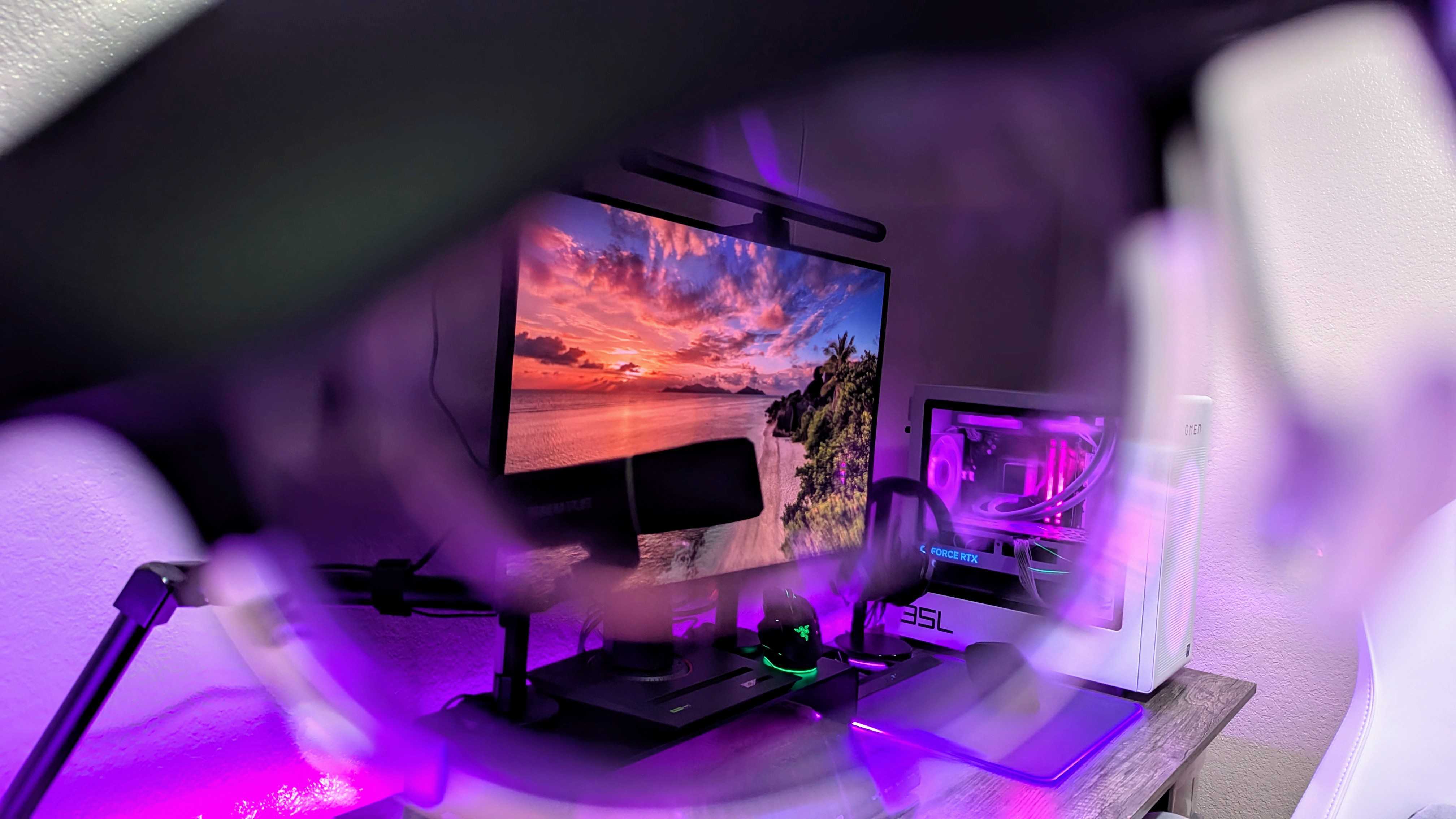
That's genuinely useful for not becoming too detached from the world, but the actual displays are solid, too. Familiar FHD micro-OLED panels, the AirVision M1's displays (which combine into one in your vision) are colorful, accurate, and decently sharp.
Reading, researching, gaming, watching, browsing, it all looked pretty great on these glasses, and the optional AirVision app gives you ways to adjust the size and distance of the screen, the color profile of the displays, and configure custom multi-window setups.
The AirVision app also enables 3-degrees-of-freedom (3DoF) tracking and gesture controls for the On-Screen Display (OSD), making it feel more like a necessity than an optional enhancement.
At least the app is lightweight, intuitive, and stable — it's better than XREAL's in-progress offering (who's moving away from relying on external software), but lesser than VITURE's more comprehensive ecosystem.
You don't have much control over the sensors, but ambient light and proximity sensors aim to improve the user experience by adjusting the brightness and detecting when you're wearing or not wearing the glasses. These displays are quite bright, too, peaking at up to 1,100 nits, although that's not industry-leading.
The stereo speakers do sound a bit flat and hollow, but are clear and detailed even at max volume, which is higher than I expected. Generally, the ASUS AirVision M1 doesn't outright fail any of the fundamentals, and the glasses are comfortable to wear
AirVision M1 review: What I don't like
I made it clear early on that I don't recommend buying the ASUS AirVision M1, and that's true whether you're comparing it to other AR glasses or evaluating this wearable all on its own.
Simply put, the AirVision M1 glasses aren't as advanced as other options. Its 38-degree field-of-view (FoV) is noticeably narrower than the 46 to 57-degree FoV of the AR glasses I'd recommend, and its 72Hz refresh rate is considerably choppier than the 120Hz standard in the best wearable displays (and you can tell).
On top of that, you'd really expect electrochromic lens dimming in this price range, but the AirVision M1 lacks it entirely — you're always stuck with that 60% optical transparency, which will be a detriment in brighter environments.
You need the AirVision software to enable a ton of features, including full 3DoF head tracking (we're starting to see AR glasses that can do all of that onboard), and that tracking is still shaky and prone to drifting. The AirVision app is only available on Windows, anyway, so you'll lose a lot of functionality on other devices.
That includes gestures. The OSD is only enabled with the AirVision app, so the touchpad on the side of the AirVision M1 is useless at all other times. That touchpad is a poor replacement for proper, tactile controls, too, frequently missing or misinterpreting inputs.
The real killer, though, is that the AirVision M1 costs $700, for some unknown reason (and no reason would be good enough). The XREAL One with its 50-degree FoV, 120Hz refresh rate, 5,000 nits peak brightness, onboard 3DoF tracking, expanded device compatibility, and electrochromic lens is only $549.
AirVision M1 review: Also consider
VITURE Pro XR Glasses
Buy now: $459 at Amazon
VITURE's comprehensive ecosystem and software, thorough design, and great overall user experience makes the Pro XR Glasses the obvious alternative to the overpriced AirVision M1. The base capabilities are the same, but these do it so much better.
👉See at: Amazon.com or BestBuy.com
XREAL One
Buy now: $549 at Amazon
If you want to go up another tier, XREAL is still the king with its new One glasses, which use custom silicon to enable fully native, seamless 3DoF tracking with countless devices (without software). This is the future of AR glasses, and it's still cheaper than the AirVision M1.
Tom's Guide review ⭐⭐⭐⭐½
👉See at: Amazon.com
AirVision M1 review: My final thoughts
✅You should buy this if ...
- You very specifically want ASUS AR glasses, for some reason.
- You find the AirVision M1 massively discounted, like 40% or more.
❌You should not buy this if ...
- You want AR glasses that are actually worth what you pay.
- You want 3DoF spatial tracking with more than just your Windows devices.
- You want features like electrochromic lens or a high refresh rate.
Wearable technology is still an evolving category, with dozens of companies each trying to find new ways to make our lives easier outside of a new app on our smartphones.
AR glasses are a huge part of this movement, with companies like XREAL, VITURE, Meta, and more each taking different approaches. The category is established, though, making it all the more baffling that ASUS so completely missed the mark here.
Look, the ASUS AirVision M1 glasses are fine. They're not exceptional in any way, but they do hit the fundamentals and function exactly as you'd expect. The issue is how these glasses feel so far behind the competition in everything but software.
Lesser capabilities and fewer features would be enough on their own to point you to another option, but the AirVision M1 also costs $699 at ASUS. Considering most great AR glasses fall between $300 and $500, and even the most advanced will run you $600, that pricing is utterly unfeasible.
Unless ASUS mysteriously discounts these glasses by a rather ridiculous amount, don't buy them. Go get an XREAL One for $549 at Amazon, and thank me later.
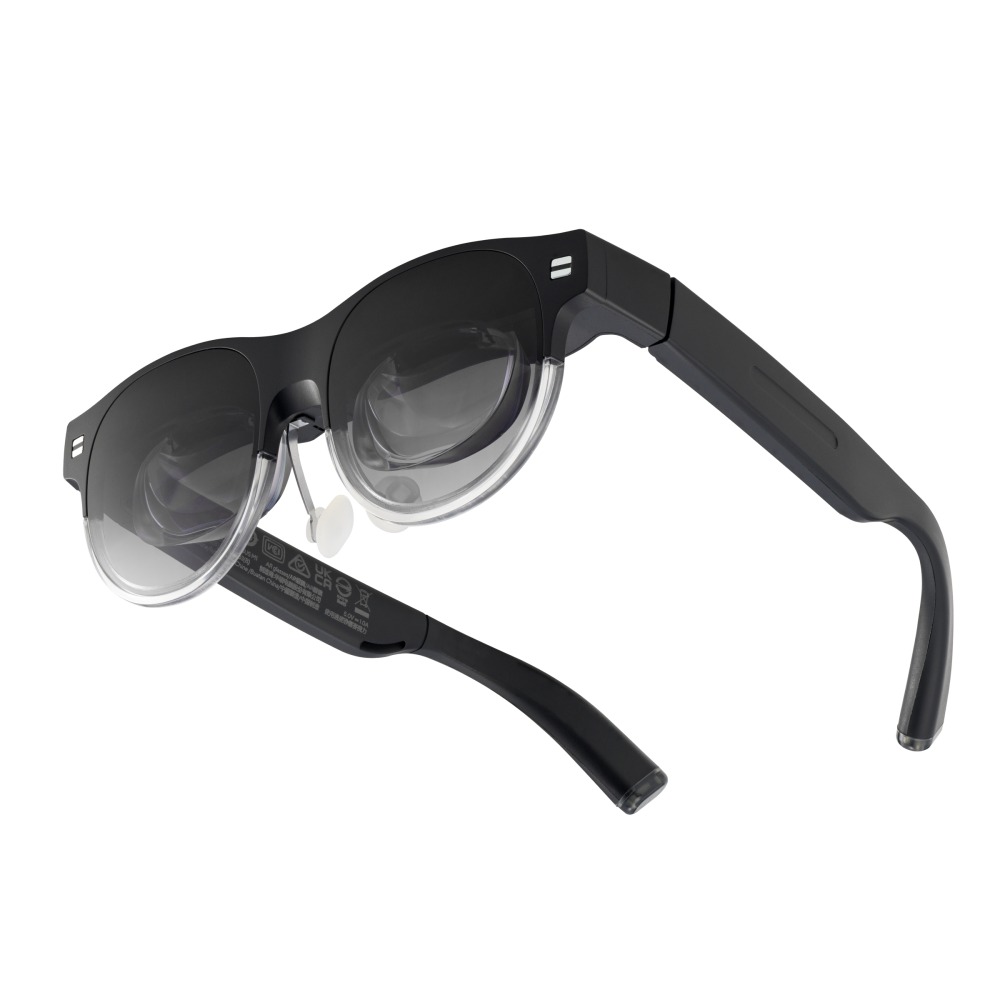
The AirVision M1 would be good — but not great — if evaluated in a vacuum, but absurdly high pricing makes it impossible to recommend these glasses, even if they're not fundamentally broken or unusable in any way. Right now, XREAL is still the best place to go for a great pair of AR glasses.

Zachary Boddy (They / Them) is a Staff Writer for Windows Central, primarily focused on covering the latest news in tech and gaming, the best Xbox and PC games, and the most interesting Windows and Xbox hardware. They have been gaming and writing for most of their life starting with the original Xbox, and started out as a freelancer for Windows Central and its sister sites in 2019. Now a full-fledged Staff Writer, Zachary has expanded from only writing about all things Minecraft to covering practically everything on which Windows Central is an expert, especially when it comes to Microsoft.
You must confirm your public display name before commenting
Please logout and then login again, you will then be prompted to enter your display name.



